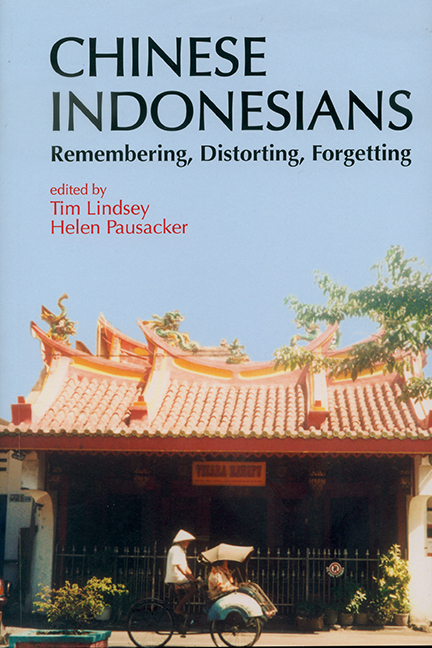Book contents
- Frontmatter
- Contents
- Preface
- A Brief Biography
- Contributors
- Glossary
- Introduction: Researching the Margins
- Bibliography of Charles Coppel's Work
- 1 Anti-Chinese Violence and Transitions in Indonesia: June 1998–October 1999
- 2 Reconstituting the Ethnic Chinese in Post-Soeharto Indonesia: Law, Racial Discrimination, and Reform
- 3 Buddhism and Confucianism in Contemporary Indonesia: Recent Developments
- 4 Portrait of the Chinese in Post-Soeharto Indonesia
- 5 The Makam Juang Mandor Monument: Remembering and Distorting the History of the Chinese of West Kalimantan
- 6 Confucianists and Revolutionaries in Surabaya (c1880–c1906)
- 7 The Chinese and the Early Centuries of Conversion to Islam in Indonesia
- 8 The Agony of Love: A Study of Peranakan Chinese Courtship and Marriage
- 9 Peranakan Chinese and Wayang in Java
- Index
7 - The Chinese and the Early Centuries of Conversion to Islam in Indonesia
Published online by Cambridge University Press: 21 October 2015
- Frontmatter
- Contents
- Preface
- A Brief Biography
- Contributors
- Glossary
- Introduction: Researching the Margins
- Bibliography of Charles Coppel's Work
- 1 Anti-Chinese Violence and Transitions in Indonesia: June 1998–October 1999
- 2 Reconstituting the Ethnic Chinese in Post-Soeharto Indonesia: Law, Racial Discrimination, and Reform
- 3 Buddhism and Confucianism in Contemporary Indonesia: Recent Developments
- 4 Portrait of the Chinese in Post-Soeharto Indonesia
- 5 The Makam Juang Mandor Monument: Remembering and Distorting the History of the Chinese of West Kalimantan
- 6 Confucianists and Revolutionaries in Surabaya (c1880–c1906)
- 7 The Chinese and the Early Centuries of Conversion to Islam in Indonesia
- 8 The Agony of Love: A Study of Peranakan Chinese Courtship and Marriage
- 9 Peranakan Chinese and Wayang in Java
- Index
Summary
INTRODUCTION
The Chinese community in Indonesia has been the focus of Charles Coppel's life of scholarship. He has examined the history of Chinese migration to Indonesia and focussed on the legal status of the Chinese, their relationship to minority communities of Christians and Arabs, and on the space Chinese occupy in independent Indonesia (Coppel 2002). The occasion of the celebration of Charles Coppel's academic career has prompted me to tease out from the writings of a number of (mainly Western) specialists some connections between the Chinese and Islam in Indonesia. The survey suggests that an important function played by the Chinese in the history of Indonesian societies was to hook those societies into an Islamic network that exposed them to Muslim people, ideas, and knowledge.
Linking the Chinese to Islam's origins in the Malay–Indonesian world is a sensitive subject in Indonesia. And yet there is a persistent association between the Chinese and Islam, especially in traditions narrating Islam's early beginnings in Java. In North Java, for example, from Banten to Kudus, Chinese cultural influences are discernible in the construction of old mosques with their characteristic tiered roofs with curving finials (Salmon 1980; Heuken 1982). Chinese cultural influences are evident in the ceramic plates embedded in the walls of the Cirebon palaces (Tjahjono 1999, p. 87) and in the colours and motifs of Cirebon batik cloths (Elliot 1984). Chinese metalworks and gun foundries and Chinese militias created the military importance of the sultanate of Gresik in the sixteenth century (Carey, P. 1984). According to Chinese tradition, the port had been founded by the Chinese in the fourteenth century (Ricklefs 2001, p. 45).
- Type
- Chapter
- Information
- Chinese IndonesiansRemembering, Distorting, Forgetting, pp. 148 - 164Publisher: ISEAS–Yusof Ishak InstitutePrint publication year: 2005



